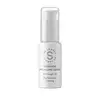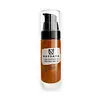What's inside
What's inside
 Key Ingredients
Key Ingredients

 Benefits
Benefits

 Concerns
Concerns

 Ingredients Side-by-side
Ingredients Side-by-side

Water
Skin ConditioningGlycerin
HumectantLactobacillus Ferment
Skin ConditioningChlamydomonas Reinhardtii Extract
HumectantAdansonia Digitata Seed Oil
EmollientLactobacillus Ferment Lysate
Skin ConditioningLysolecithin
EmulsifyingSclerotium Gum
Emulsion StabilisingSodium Hyaluronate
HumectantPullulan
Xanthan Gum
EmulsifyingSodium Dehydroacetate
PreservativeParfum
MaskingTocopherol
AntioxidantHelianthus Annuus Seed Oil
EmollientMalic Acid
BufferingSilica
AbrasiveLeuconostoc/Radish Root Ferment Filtrate
AntimicrobialWater, Glycerin, Lactobacillus Ferment, Chlamydomonas Reinhardtii Extract, Adansonia Digitata Seed Oil, Lactobacillus Ferment Lysate, Lysolecithin, Sclerotium Gum, Sodium Hyaluronate, Pullulan, Xanthan Gum, Sodium Dehydroacetate, Parfum, Tocopherol, Helianthus Annuus Seed Oil, Malic Acid, Silica, Leuconostoc/Radish Root Ferment Filtrate
Aloe Barbadensis Leaf Juice
Skin ConditioningWater
Skin ConditioningNiacinamide 3%
SmoothingGlycerin
HumectantAspalathus Linearis Leaf Extract 1.3%
Skin ConditioningCitric Acid
BufferingLysolecithin
EmulsifyingSclerotium Gum
Emulsion StabilisingCannabis Sativa Seed Oil
EmollientSodium Benzoate
MaskingPullulan
Xanthan Gum
EmulsifyingCentella Asiatica Leaf Extract
Skin ConditioningSodium Hyaluronate
HumectantAdansonia Digitata Seed Oil
EmollientPotassium Sorbate
PreservativeTocopherol
AntioxidantArgania Spinosa Kernel Oil
EmollientSodium Phytate
Ubiquinone
AntioxidantGlycine Soja Oil
EmollientSilica
AbrasiveHydroxypropyl Cyclodextrin
MaskingHippophae Rhamnoides Fruit Extract
Skin ConditioningCurcuma Longa Root Extract
MaskingChlorella Vulgaris Powder
Skin ConditioningTetrahydropiperine
Skin ConditioningGlycyrrhiza Glabra Root Extract
BleachingCalendula Officinalis Flower Extract
MaskingPalmitoyl Tripeptide-38
Skin ConditioningAloe Barbadensis Leaf Juice, Water, Niacinamide 3%, Glycerin, Aspalathus Linearis Leaf Extract 1.3%, Citric Acid, Lysolecithin, Sclerotium Gum, Cannabis Sativa Seed Oil, Sodium Benzoate, Pullulan, Xanthan Gum, Centella Asiatica Leaf Extract, Sodium Hyaluronate, Adansonia Digitata Seed Oil, Potassium Sorbate, Tocopherol, Argania Spinosa Kernel Oil, Sodium Phytate, Ubiquinone, Glycine Soja Oil, Silica, Hydroxypropyl Cyclodextrin, Hippophae Rhamnoides Fruit Extract, Curcuma Longa Root Extract, Chlorella Vulgaris Powder, Tetrahydropiperine, Glycyrrhiza Glabra Root Extract, Calendula Officinalis Flower Extract, Palmitoyl Tripeptide-38
Ingredients Explained
These ingredients are found in both products.
Ingredients higher up in an ingredient list are typically present in a larger amount.
Baobab seed oil is an emollient. It is rich in fatty acids and vitamins A, E, and D.
The fatty acid content of this oil is roughly 30-40% oleic acid, 24-34% linoleic acid, and 18-30% palmitic acid. This gives it skin hydrating and nourishing properties.
Due to this fatty acid content, this ingredient may not be fungal-acne safe.
Fun fact: Our skin uses fatty acids, and especially linoleic acid, for creating ceramides.
Learn more about Adansonia Digitata Seed OilGlycerin is already naturally found in your skin. It helps moisturize and protect your skin.
A study from 2016 found glycerin to be more effective as a humectant than AHAs and hyaluronic acid.
As a humectant, it helps the skin stay hydrated by pulling moisture to your skin. The low molecular weight of glycerin allows it to pull moisture into the deeper layers of your skin.
Hydrated skin improves your skin barrier; Your skin barrier helps protect against irritants and bacteria.
Glycerin has also been found to have antimicrobial and antiviral properties. Due to these properties, glycerin is often used in wound and burn treatments.
In cosmetics, glycerin is usually derived from plants such as soybean or palm. However, it can also be sourced from animals, such as tallow or animal fat.
This ingredient is organic, colorless, odorless, and non-toxic.
Glycerin is the name for this ingredient in American English. British English uses Glycerol/Glycerine.
Learn more about GlycerinWe don't have a description for Lysolecithin yet.
Pullulan is a low viscosity polysaccharide (a long chain carbohydrate) with binding and film forming properties when dissolved in water. It is used to create a "silicone-like" or silky feel in cosmetics without adding viscosity.
According to a manufacturer, this ingredient's ability to easily dissolves makes it a great carrier for active ingredients.
Due to it being edible and tasteless, you'll likely find this ingredient in breath freshener strips. This ingredient is produced from the starch of the fungus, Aureobasidium pullulans.
Pullulan is stable over a broad-range of pH.
Learn more about PullulanSclerotium Gum is a polysaccharide gum made by the fungus, Sclerotium rolfssii. It is similar to xanthan gum.
In cosmetics, Sclerotium Gum is used to thicken the texture and to help stabilize other ingredients.
As an emulsifier, Sclerotium Gum helps prevent ingredients from separating, such as water and oil.
Learn more about Sclerotium GumSilica, also known as silicon dioxide, is a naturally occurring mineral. It is used as a fine, spherical, and porous powder in cosmetics.
Though it has exfoliant properties, the function of silica varies depending on the product.
The unique structure of silica enhances the spreadability and adds smoothness, making it a great texture enhancer.
It is also used as an active carrier, emulsifier, and mattifier due to its ability to absorb excess oil.
In some products, tiny microneedles called spicules are made from silica or hydrolyzed sponge. When you rub them in, they lightly polish away dead skin layers and enhance the penetration of active ingredients.
Learn more about SilicaSodium Hyaluronate is hyaluronic acid's salt form. It is commonly derived from the sodium salt of hyaluronic acid.
Like hyaluronic acid, it is great at holding water and acts as a humectant. This makes it a great skin hydrating ingredient.
Sodium Hyaluronate is naturally occurring in our bodies and is mostly found in eye fluid and joints.
These are some other common types of Hyaluronic Acid:
Learn more about Sodium HyaluronateTocopherol (also known as Vitamin E) is a common antioxidant used to help protect the skin from free-radicals and strengthen the skin barrier. It's also fat soluble - this means our skin is great at absorbing it.
Vitamin E also helps keep your natural skin lipids healthy. Your lipid skin barrier naturally consists of lipids, ceramides, and fatty acids. Vitamin E offers extra protection for your skin’s lipid barrier, keeping your skin healthy and nourished.
Another benefit is a bit of UV protection. Vitamin E helps reduce the damage caused by UVB rays. (It should not replace your sunscreen). Combining it with Vitamin C can decrease sunburned cells and hyperpigmentation after UV exposure.
You might have noticed Vitamin E + C often paired together. This is because it is great at stabilizing Vitamin C. Using the two together helps increase the effectiveness of both ingredients.
There are often claims that Vitamin E can reduce/prevent scarring, but these claims haven't been confirmed by scientific research.
Learn more about TocopherolWater. It's the most common cosmetic ingredient of all. You'll usually see it at the top of ingredient lists, meaning that it makes up the largest part of the product.
So why is it so popular? Water most often acts as a solvent - this means that it helps dissolve other ingredients into the formulation.
You'll also recognize water as that liquid we all need to stay alive. If you see this, drink a glass of water. Stay hydrated!
Learn more about WaterXanthan gum is used as a stabilizer and thickener within cosmetic products. It helps give products a sticky, thick feeling - preventing them from being too runny.
On the technical side of things, xanthan gum is a polysaccharide - a combination consisting of multiple sugar molecules bonded together.
Xanthan gum is a pretty common and great ingredient. It is a natural, non-toxic, non-irritating ingredient that is also commonly used in food products.
Learn more about Xanthan Gum